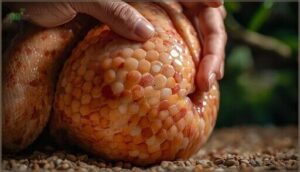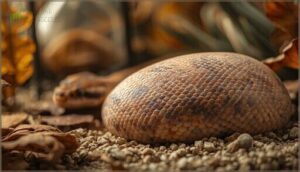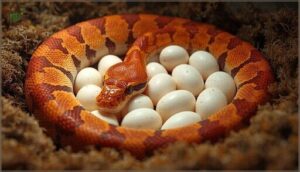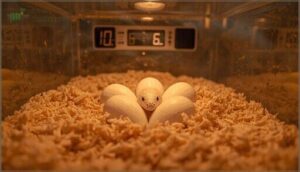This site is supported by our readers. We may earn a commission, at no cost to you, if you purchase through links.
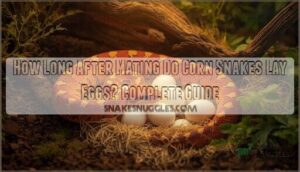
The first real sign comes around day 23, when she goes through her pre-lay shed, signaling that egg-laying is just around the corner. Missing this timeline or ignoring key environmental factors can lead to complications like egg binding or failed clutches.
Knowing what to expect during those critical weeks between copulation and egg deposition helps you set up the right nesting conditions, monitor your snake’s health, and give those eggs the best shot at successful incubation.
Table Of Contents
- Key Takeaways
- How Long After Mating Do Corn Snakes Lay Eggs?
- What Triggers Egg Development in Corn Snakes?
- How to Tell if a Female Corn Snake is Gravid
- What is The Average Gestation Period?
- Preparing for Corn Snake Egg Laying
- What Happens During The Egg-Laying Process?
- Caring for Eggs After Laying
- Common Problems With Egg Laying
- How Environmental Factors Affect Egg Laying
- Tips for Successful Breeding and Egg Laying
- Frequently Asked Questions (FAQs)
- Conclusion
Key Takeaways
- Your female corn snake will typically lay eggs 30 to 45 days after mating, with the pre-lay shed around day 23 serving as your most reliable countdown marker before egg deposition occurs within 7 to 14 days.
- Temperature, female health, and environmental stress directly impact the egg-laying timeline—temperatures below 68°F can delay laying by two weeks, while poor nutrition or frequent handling increases complications like egg binding.
- Creating a proper nesting environment with a humid hide (70% humidity), stable temperatures between 78–84°F, and minimal disturbance during the laying process prevents serious health risks and ensures successful egg deposition.
- Successful incubation requires precise environmental control at 82°F with 85–90% humidity using substrates like vermiculite, along with careful daily monitoring without rotating the eggs to protect developing embryos.
How Long After Mating Do Corn Snakes Lay Eggs?
After a successful mating, you can expect your female corn snake to lay her eggs in about 30 to 45 days. This timeframe isn’t set in stone, though—several factors can shift this window earlier or later.
Let’s look at what influences this timeline and what you should watch for during this period.
Typical Post-Mating Timeline
After mating, your corn snake will usually lay eggs within 30 to 45 days. This gestation period follows a predictable pattern you can track through careful mating observation. The most reliable marker you’ll notice is the pre-lay shed, which usually occurs around 23 days after breeding. Once you see this shed, expect egg laying within 7 to 14 days.
Most breeding records show females depositing their clutch between 4 and 8 weeks post-copulation, with 6 weeks being the average. Understanding this corn snake egg laying process helps you prepare the nesting site in advance. It’s also important to provide a dark, secure environment for the snake to lay its eggs.
Factors Affecting Egg-Laying Interval
While 30 to 45 days is typical, several factors can shift this timeline. Here’s what influences your corn snake’s gestation period:
- Female Health: Snakes with poor body condition or parasitic infections can delay egg laying by 7 to 30 days, while well-nourished females stay on schedule.
- Temperature Effects: Temperatures below 68°F can extend the interval by up to 2 weeks, highlighting temperature influence on breeding success.
- Environmental Stressors: Frequent handling or loud noises increase egg retention risk from 5% to 17%.
- Genetic Variation: Individual variations in breeding mean clutchmates can differ by 12 days under identical conditions. Successful incubation relies on maintaining consistent temperature and humidity.
What Triggers Egg Development in Corn Snakes?
Egg development in corn snakes doesn’t just happen automatically after mating—it’s actually triggered by a combination of environmental signals and internal hormonal shifts. Understanding these triggers helps you create the right conditions for successful reproduction and ensures your female snake is truly ready to produce viable eggs.
Let’s look at the two main factors that kick-start this process.
Brumation and Environmental Cues
Before your corn snake can successfully reproduce, brumation acts as nature’s reset button—triggering the seasonal rhythms essential for breeding season. You’ll need to cool your snakes to 50–61°F for 60–90 days, generally December through February. This temperature influence on breeding synchronizes reproductive readiness.
Environmental manipulation extends beyond cooling, though. Photoperiod effects matter too—reducing light to under 10 hours daily mimics winter, then increasing to 12–14 hours post-brumation signals spring’s arrival. Humidity control between 40–60% prevents health issues during dormancy.
These environmental factors impact every aspect of reproduction, from ovulation to nesting cues that prepare females for egg-laying.
Hormonal Changes After Mating
Once brumation sets the stage, pituitary activation kicks in right after mating. Within hours, your female corn snake experiences a surge in follicle-stimulating hormone (FSH) and luteinizing hormone (LH), jumpstarting follicle development.
An estradiol surge peaks around six hours post-mating, then drops by 24 hours—this brief spike signals the reproductive cycle to accelerate. Progesterone levels climb steadily as eggs mature, rising from under 2 ng/mL to over 10 ng/mL.
These hormone feedback mechanisms coordinate fertilization in corn snakes and regulate the entire corn snake pregnancy, ensuring your female corn snake progresses smoothly toward egg-laying.
How to Tell if a Female Corn Snake is Gravid
Figuring out whether your female corn snake is carrying eggs isn’t always obvious at first glance. You’ll need to watch for both physical changes in her body and shifts in her usual behavior.
Let’s look at the telltale signs that indicate she’s gravid and getting ready to lay.
Physical Signs of Gravid Females
Spotting corn snake pregnancy early helps you prepare for the clutch to come. Gravid corn snakes often show abdominal swelling in their lower third, starting 10–21 days after mating, giving you a visual clue that follicles are developing.
You’ll notice weight gain of 10–20% above baseline, and a lumpy midsection that feels firm when you gently run your fingers along her ventral surface—though palpation accuracy exceeds 90% in studies, you should minimize handling to avoid injury.
Shedding changes also occur, with females experiencing a pre-lay shed 2–3 weeks before egg laying, marking the final countdown.
Behavioral Changes Before Egg Laying
As your female corn snake enters the prelaying shed period, you’ll see dramatic behavioral shifts that signal eggs are coming soon. Increased locomotion appears first—pregnant females pace relentlessly, surfing tank walls and circling their enclosure.
Feeding changes follow, with 80% refusing meals 10–14 days before laying. Watch for nesting behavior like piling substrate and repeatedly checking humid hides; this tells you oviposition is 48 hours away.
Gravid corn snakes may also show defensive actions, jerking when touched or hiding more. Finally, expect decreased activity—your once-restless female corn snake becomes eerily still right before laying begins.
What is The Average Gestation Period?
Once you’ve confirmed your female is gravid, the waiting game begins. Most corn snakes lay their eggs 30 to 45 days after a successful mating, though this timeline isn’t set in stone.
Let’s look at what influences this gestation period and why some females don’t follow the textbook schedule.
Days Between Mating and Egg Laying
After your corn snake mates, you’re probably counting down the days until eggs appear. The gestation period—the interval between mating and egg laying—usually spans 30 to 45 days, with most females hitting the four-week mark. Controlled studies show clutches arrive around 34 days post-copulation under best conditions.
This gestation timeline ties directly to temperature and light exposure, so interval factors matter. Watch for the pre-lay shed about 10 to 14 days before oviposition, a reliable signal within the corn snake gestation process.
Seasonal breeding in spring generally keeps clutch intervals predictable and consistent.
Variability in Gestation Length
Not every corn snake follows the exact same calendar—gestation period variability can surprise you. While 30 to 45 days is typical, individual differences shift that window. Temperature plays a huge role: gestation at 28°C averages 32 days, but drops to 22°C can push it past 40 days.
Other factors that influence gestation length include:
- Dietary Influences: Well-fed females may lay eggs around 29 days, while underfed ones take up to 41 days.
- Genetic Factors: Certain lineages consistently show 5-day shorter gestation periods.
- Seasonal Impact: Late-season matings extend gestation by up to 7 days.
- Health Conditions: Illness or dehydration can add 5 to 8 days.
Environmental factors and humidity matter too—watch your setup closely.
Preparing for Corn Snake Egg Laying
Once you know your female is gravid, it’s time to set up the right environment for egg laying. Getting this step right can mean the difference between a smooth laying process and potential complications.
Let’s look at the two key elements you’ll need to prepare: a proper nesting site and the correct temperature and humidity levels.
Creating a Suitable Nesting Site
A comfortable nesting spot can make all the difference when your gravid female gets ready to lay. Start by setting up a nest box that’s at least 10″ x 6″ x 4″—large enough for her to coil completely. Place it in the nesting area on the warmer side of the enclosure, and line the interior with damp sphagnum moss or coconut fiber to maintain proper moisture.
Your substrate depth throughout the enclosure should be at least 3 inches, allowing natural burrowing behaviors. Add enrichment elements like logs and plants for privacy, and follow basic hygiene protocols by spot-cleaning regularly.
Temperature and Humidity Requirements
Getting the environment just right directly impacts your hatch rate and the health of those future hatchlings. Once eggs are laid, you’ll need precise environmental control to support successful development.
Here’s what you need to focus on for egg incubation:
- Ideal Temperature: Maintain 78–84°F, with 82°F being the sweet spot for consistent results and reliable hatching timelines.
- Humidity Levels: Keep relative humidity between 85–90% using humidity monitoring equipment like digital hygrometers placed near the eggs.
- Incubation Substrates: Use moistened vermiculite or perlite to stabilize humidity control throughout the 58–70 day period.
- Temperature Regulation: Check daily with dual thermometers to prevent fluctuations that could harm developing embryos.
What Happens During The Egg-Laying Process?
Once your female corn snake is ready to lay her eggs, the process unfolds in distinct stages that you’ll want to observe carefully. Understanding what happens during egg-laying helps you provide the right support and avoid unnecessary interference.
Let’s look at the key behaviors you’ll notice and what to expect from the clutch.
Egg-Laying Behavior and Duration
Once your female starts laying, you’ll notice the egg-laying process usually wraps up within 12 to 24 hours. However, laying duration factors like clutch size and environmental disturbances can extend this to 36 hours in rare cases.
Watch for physiological signs including restlessness and test burrowing as she gets ready her nest. Case variability means some individuals experience incomplete oviposition if conditions aren’t ideal, leading to nesting aversion.
Don’t disturb her during this critical time—stress can interrupt the natural rhythm and cause complications with her clutch.
Clutch Size Expectations
After the laying wraps up, you can expect a clutch anywhere from 10 to 25 eggs on average. Female corn snakes that are larger or well-fed before mating often produce bigger clutches—sometimes up to 30 eggs or more. Environmental influences and nutrition play a big role in determining how many eggs you’ll see.
Here’s what affects clutch size:
- Size correlation: Longer females generally lay more eggs per clutch
- Double clutching: Some captive females produce a smaller second clutch weeks later
- Egg characteristics: Each egg measures roughly 3.8 to 6.4 cm in length
Caring for Eggs After Laying
Once your female corn snake has finished laying her eggs, your job shifts to protecting and incubating them properly. Handling them the right way from the start makes all the difference in whether they develop successfully.
Here’s what you need to know about collecting the eggs and creating the ideal incubation setup.
Safe Collection and Handling
Once your female lays her clutch, you’ll want to collect the corn snake eggs within 12 hours to prevent them from sticking together. Support each egg fully from beneath and mark the top with a soft pencil to maintain proper egg orientation throughout egg development. Don’t rotate them during transfer, as this can disrupt the embryo.
Before handling, sterilize your work surface with a diluted bleach solution or 3% hydrogen peroxide—this mold prevention step is critical for egg care. Use clean, ventilated containers with moist substrate (85-95% humidity) for safe egg laying recovery and storage.
Setting Up an Incubation Environment
After you’ve collected and marked your eggs, the incubation environment becomes your next priority. Container choice matters—plastic tubs with tight lids retain humidity levels best. For substrate selection, vermiculite or coconut coir works well when moistened until clumping but not dripping.
Temperature control is critical: keep your incubator choice set between 78°F and 84°F, ideally 82°F, for consistent egg development. Humidity levels should stay around 65-75%, measured with a digital hygrometer.
These incubation conditions directly impact hatching success, so failure prevention starts with careful monitoring. Proper incubation methods mean checking daily without rotating eggs.
Common Problems With Egg Laying
While egg laying usually goes smoothly, complications can arise that put your female corn snake at risk. Recognizing potential problems early gives you the best chance to intervene and protect her health.
Let’s look at the most common issues you might encounter and what causes them.
Egg Binding and Health Risks
When egg binding—technically called dystocia—strikes your corn snake, it’s more than just an inconvenience. This condition develops when retained eggs can’t pass normally, and dystocia prevalence among captive reptiles shows it’s not uncommon.
Nutritional deficiencies in calcium or vitamin D often contribute to the problem, weakening the muscles needed for laying. Left untreated, egg binding leads to serious health problems like coelomitis (body cavity inflammation) or prolapse complications.
You’ll need veterinary checkups promptly if your female shows persistent straining or lethargy. Surgical options become necessary in severe cases, though they may affect future reproductive health.
Stress Factors Impacting Laying
When environmental factors impact your corn snake’s laying process, you’re dealing with five major stress categories that threaten reproductive health and animal wellbeing. Handling stress increases stress hormones by 46% within just 24 hours, reducing egg viability by up to 22%. Temperature stress above 89°F raises egg binding cases by 19%. Individual variations in breeding mean some females handle these challenges better than others, but no snake is immune.
Watch for these critical stressors:
- Social disturbance from nearby snakes boosting parasite loads to 20.4%
- Nutritional stress from irregular feeding dropping clutch size by 22%
- Parasitic stress causing 14% more clutch failures
- Environmental factors impact like inadequate humidity reducing hatch rates by 24%
How Environmental Factors Affect Egg Laying
Your female corn snake’s environment plays a bigger role in successful egg laying than you might think. Even if everything else goes right—mating, timing, nutrition—the wrong temperature or humidity can derail the whole process.
Let’s look at the two most critical environmental factors that directly impact when and how your snake lays her eggs.
Temperature Fluctuations
Temperature stability during egg incubation isn’t just important—it’s essential. Your corn snake’s eggs thrive between 75–85°F, with ideal conditions near 81–83°F. Going beyond 85°F can cause serious problems, including deformities and lower survival rates.
Even minor fluctuations affect embryo development, altering metabolic consequences and hatchling fitness. Prolonged exposure to unstable temperatures weakens hatchlings, impacting their size and feeding ability. That’s why consistent temperature control matters so much.
Use digital probe thermometers to monitor multiple spots in your incubation setup. Avoid heat sources that spike unpredictably—gentle, steady warmth produces healthier, more vigorous babies with better long-term survival rates.
Humidity and Nest Site Choice
Where your female corn snake chooses to lay makes all the difference. In the wild, she seeks humid microhabitats beneath rotting logs or in loose soil, prioritizing moisture retention. You’ll want to replicate this instinct in captivity by offering a dedicated nesting area with proper humidity levels around 70%.
Provide a humid hide lined with moist sphagnum moss on the warm side of her enclosure. This nesting substrate prevents egg desiccation while encouraging natural nesting behaviors. Without adequate humidity at the nesting spot, eggs dry out quickly, and your female may even retain eggs—risking dangerous complications.
Tips for Successful Breeding and Egg Laying
Breeding corn snakes successfully takes more than just pairing them up and hoping for the best. You’ll need to stay on top of your female’s health throughout the process and keep detailed records to improve your results over time.
Let’s look at two key practices that’ll set you up for breeding success season after season.
Monitoring Female Health
You can think of monitoring female corn snake health like maintaining a high-performance engine—regular checks prevent breakdowns. Weight monitoring tracks your snake’s body condition, ideally between 300 and 800 grams for healthy adults. Cardiac tracking helps detect stress through heart rate changes, while infection surveillance catches issues like respiratory problems before they escalate. Watch for stress indicators such as reduced basking or appetite increase before prenatal shedding.
Three key nutritional protocols include:
- Increasing feeding frequency by 20–30% before breeding
- Supplementing calcium at 1–2 mg per gram of body weight
- Providing support feedings within 48 hours post-laying
These practices support reproductive health throughout the breeding cycle.
Record Keeping and Planning for Future Breeding
Breeding success hinges on detailed logs—78% of breeders track lineage and morph genetics for every clutch. You’ll want to record mating dates, clutch statistics (size, hatch rates), and health records for each reproductive cycle.
Digital tools or spreadsheets help you plan breeding schedules, spacing pairings at least 12 months apart per female. Historical data guides genetic selection, boosting desired phenotypes by 21%.
Here’s what effective record keeping looks like:
| Data Point | Why It Matters |
|---|---|
| Breeding dates | Times your breeding season accurately |
| Clutch size | Tracks reproductive health trends |
| Hatch success | Identifies best breeding cycles |
| Female weight | Prevents overbreeding stress |
| Genetic outcomes | Guides future pairing decisions |
Frequently Asked Questions (FAQs)
Can corn snakes lay eggs without mating?
Yes, corn snakes can lay unfertilized eggs without mating through parthenogenesis—a rare form of asexual reproduction.
While uncommon in captive breeding, this process produces offspring genetically similar to their mother, offering unique evolutionary advantages.
How many times do corn snakes breed yearly?
Unlike their Victorian-era counterparts in breeding circles, wild corn snakes generally breed once annually during breeding season (March–June). However, captive breeding programs can achieve 2-3 clutches yearly under ideal conditions, dramatically altering their natural breeding cycle.
What do unfertilized corn snake eggs look like?
Unfertilized corn snake eggs appear soft, leathery, and white or translucent. They lack visible veins when candled, showing no embryonic development.
Appearance variations include yellowish tinting or irregular shapes, often indicating infertility.
Do corn snakes need a mate every year?
You might assume snakes reproduce at every opportunity, but corn snakes don’t need annual mating.
Breeding frequency impacts health implications and energy reserves considerably. Biennial reproductive habits support better lifespan impact and overall wellness.
How long can females store sperm before laying?
Female corn snakes can store sperm for over a year—sometimes up to five years—thanks to specialized tubule secretory cells in their reproductive tract.
This impressive sperm storage duration gives them amazing flexibility for fertilization timing.
Conclusion
Some breeders swear they can predict egg-laying down to the day, but the truth is, corn snakes don’t follow a rigid schedule. Even with perfect conditions, the 30 to 45 days after mating can stretch or compress based on your female’s unique rhythm.
That’s why tracking her pre-lay shed and watching for behavioral shifts matters more than circling a calendar date. Stay observant, stay flexible, and you’ll catch those eggs right on time.
- https://www.askaboutcornsnakes.com/how-long-is-a-corn-snake-pregnant-for/
- https://en.wikipedia.org/wiki/Corn_snake
- https://www.doc-developpement-durable.org/file/Elevages/Serpents/serpent-des-bles/The%20Corn%20Snake%20Guide.pdf
- https://animaldiversity.org/accounts/Pantherophis_guttatus/
- https://www.watersnake.net/floridaexpecting-mothers-understanding-clutch-sizes-in-corn-snakes.htm


